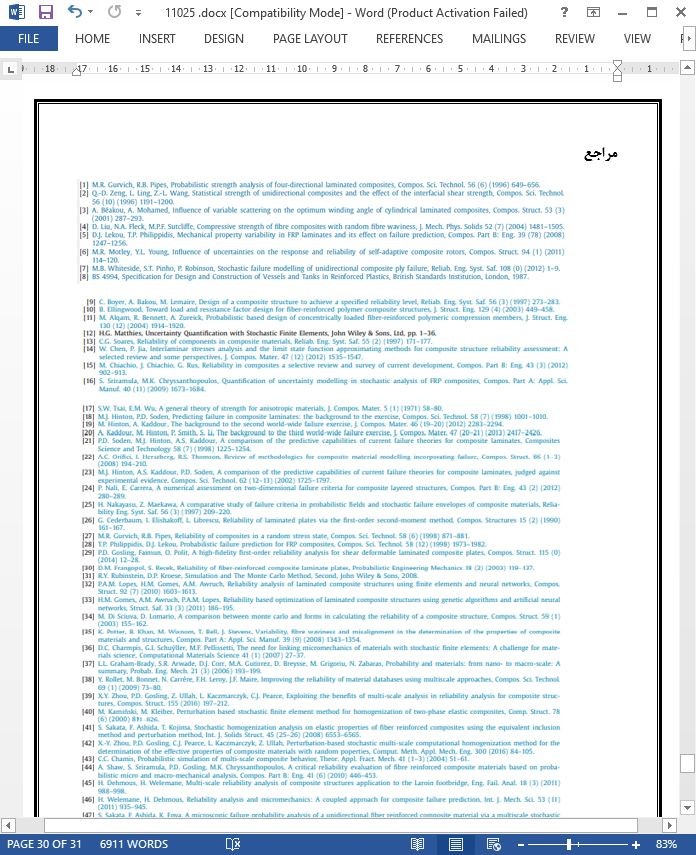
تحلیل قابلیت اطمینان مبتنی بر جز محدود چند مقیاسی تصادفی برای سازه های کامپوزیت چند لایه
چکیده
این مقاله یک روش چند مقیاسی جدید را برای تحلیل قابلیت اطمینان سازه های کامپوزیت که در برگیرنده عدم اطمینان های ماکروسکوپیک و میکروسکوپیک مانند خصوصیات مواد تشکیل دهنده و زاویه چند لایه پیشنهاد می کند. پاسخ های سازه ای تصادفی که موجب ایجاد رابطه بین پاسخ های سازه ای و متغیر های تصادفی می گردند، با استفاده از یک روش جزء محدود چند مقیاسی تصادفی به دست می آیند که هموژنیزاسیون محاسباتی را با روش جزء محدود تصادفی ترکیب می کند. این موضوع همراه با روش های قابلیت اطمینان مرتبه اول و دوم جهت ایجاد یک چارچوب تحلیل قابلیت اطمینان منحصر به فرد ارائه می شود. به منظور ارزیابی این روش، روش هموژنیزاسیون محاسباتی تعینی با روش مونت کارلو به عنوان یک روش قابلیت اطمینان جایگزین ترکیب می شود. مثال های عددی به منظور نشان دادن قابلیت روش پیشنهادی در اندازه گیری ایمنی سازه های کامپوزیت مورد استفاده قرار می گیرند. مقاله نشان می دهد که این روش برآورد های بسیار نزدیکی را به روش مونت کارلو ارائه می کند، اما از کارایی بسیار بیشتری بر حسب زمان محاسباتی برخوردار است. مشاهده می شود که این روش می تواند به عنوان یک جزء بنیادی و اصلی در ارائه روش های طراحی چند مقیاسی تصادفی برای سازه های کامپوزیت مطرح شود.
1. مقدمه
عناصر کامپوزیتی به صورت ورق هایی متشکل از چندین لایه از ورق های کامپوزیت مسلح الیافی بوده که هر کدام از الیاف های محصور در مخلوط ساخته شده اند. سرهم بندی الیاف ها و مواد مخلوط جهت ایجاد یک ورق و همچنین عمل آوری و ساخت ورق به عنوان یک فرآیند پیچیده محسوب شده و ممکن است در برگیرنده عدم اطمینان بالایی باشد. بنابراین، خصوصیات مواد یک ورق کامپوزیت دارای ماهیت تصادفی است. منابع عدم اطمینان قابل توجه عبارتند از: تغییرات نسبت های حجمی الیاف و مخلوط، حفرات در مخلوط و بین الیاف و مخلوط، پیوند ناقص بین مواد تشکیل دهنده، ترک ها، خرابی الیاف، الیاف های متراکم تصادفی یا پیوسته، الیاف های تنظیم نشده، اثرات موقت، عمل آوری غیر یکنواخت مواد مخلوط، تنش های پسماند و غیره. عدم اطمینان ها در این عوامل در مقیاس بزرگتری انتشار یافته و در تغییر پذیری سختی و مقاومت که بیان کننده رفتار سازه ای کلی است نمود می یابند. در نتیجه، ضرائب اطمینان بالای از مرتبه 10-8 در طراحی سازه ای تعینی کنونی با عدم در نظر گرفتن مزیت کلی مواد کامپوزیت به دست می آیند. می توان این موضوعات را در یک ساختار طراحی احتمالاتی معادل با به طور مثال یوروکد مورد بررسی قرار داد.
5. نتیجه گیری
در این مقاله، یک روش تحلیل قابلیت اطمینان مبتنی بر جزء محدود چند مقیاسی برای سازه های کامپوزیت پیشنهاد شده است. روش پیشنهادی موجب بررسی هر دو عدم اطمینان میکروسکوپیک مانند عدم اطمینان های موجود در خصوصیات مواد تشکیل دهنده و عدم اطمینان های ماکروسکوپیک مانند زوایای جهت گیری لایه ها می شود. چارچوب تحلیل قابلیت اطمینان جدید (PSMFEM-FORM و PSMFEM-SORM) موجب ترکیب یک روش جزء محدود چند مقیاسی تصادفی مبتنی بر آشفتگی با روش های قابلیت اطمینان مرتبه اول و دوم می شود. فرمول بندی روش هموژنیزاسیون تصتادفی و پیاده سازی جزء محدود آن مورد اشاره قرار می گیرند. روش انجام تحلیل قابیت اطمینان جزء محدود چند مقیاسی پیشنهادی به طور کامل معرفی می شود. علاوه براین، شبیه سازی مونت کارلو با روش جزء محدود چند مقیاسی تعینی جهت تشکیل MFEM-MCS به منظور ارزیابی عملکرد PSMFEM-FORM و PSMFEM-SORM ترکیب شده است.
Abstract
This paper proposes a novel multi-scale approach for the reliability analysis of composite structures that accounts for both microscopic and macroscopic uncertainties, such as constituent material properties and ply angle. The stochastic structural responses, which establish the relationship between structural responses and random variables, are achieved using a stochastic multi-scale finite element method, which integrates computational homogenisation with the stochastic finite element method. This is further combined with the first- and second-order reliability methods to create a unique reliability analysis framework. To assess this approach, the deterministic computational homogenisation method is combined with the Monte Carlo method as an alternative reliability method. Numerical examples are used to demonstrate the capability of the proposed method in measuring the safety of composite structures. The paper shows that it provides estimates very close to those from Monte Carlo method, but is significantly more efficient in terms of computational time. It is advocated that this new method can be a fundamental element in the development of stochastic multi-scale design methods for composite structures.
1. Introduction
Typical composite components are laminates comprising layers of fibre reinforced composite laminae, each of which are made of fibres embedded in matrix. The assembly of the fibres and matrix materials to create a lamina, as well as the lay up and curing of laminae, is a complicated process and may involve a lot of uncertainty. Therefore, the material properties of a composite laminate are random in nature. Sources of significant uncertainty include: variations in volume fractions of fibre and matrix, voids in the matrix and between fibres and matrix, imperfect bonding between constituents, cracks, fibre damage, random and/or contiguously packed fibres, misaligned fibres, temperature effects, non-uniform curing of the matrix material, residual stresses, etc. Uncertainties in these factors propagate to a larger scale and are reflected in variability of the stiffness and strength that characterise the overall structural behaviour [1–7]. Consequently, high safety factors of the order of 8–10 [8] are introduced in current deterministic based structural design, thereby not taking full advantage of composite materials. These issues may be addressed in a probability based design context [9–11] equivalent to Eurocode, for example.
5. Conclusions
In this paper, a multi-scale finite element based reliability analysis method is proposed for composite structures. The proposed method enables both microscopic uncertainties, such as those in constituent material properties, and macroscopic uncertainties, such as ply orientation angles, to be taken into account. The new reliability analysis framework (PSMFEMFORM and PSMFEM-SORM) couples a recently developed perturbation-based stochastic multi-scale finite element method with the first- and second-order reliability methods. Formulations of the stochastic homogenization method and its finite element implementation are described. Procedure to perform the proposed multi-scale finite element based reliability analysis methods is thoroughly introduced. In addition, Monte Carlo simulation has been coupled with the deterministic multi-scale finite element method to form the MFEM-MCS to evaluate the performance of PSMFEM-FORM and PSMFEM-SORM.
چکیده
1. مقدمه
2. روش جزء محدود چند مقیاسی تصادفی
2.1 روش هموژنیزه کردن تصادفی برای مواد کامپوزیت
2.2 پیاده سازی جزء محدود روش چند مقیاسی
3. روش های تحلیل قابلیت اطمینان ساختاری چند مقیاسی
3.1 اصل تحلیل قابلیت اطمینان ساختاری
3.2 تابع حالت حدی برای کامپوزیت ها
3.3 روش شبیه سازی مونت کارلو بر اساس جزء محدود چند مقیاسی
3.4 روش قابلیت اطمینان مرتبه اول بر اساس جزء محدود چند مقیاسی
3.5 روش قابلیت اطمینان مرتبه دوم بر اساس جزء محدود چند مقیاسی
4. مثال های عددی
4.1 مثال 1: ورق یک لایه
4.2 ورق های چند لایه
5. نتیجه گیری
Abstract
1. Introduction
2. Stochastic multi-scale finite element method
2.1. Stochastic homogenization method for composite materials
2.2. Finite element implementation of multi-scale method
3. Multi-scale structural reliability analysis methods
3.1. Fundamental of structural reliability analysis
3.2. Limit state function for composites
3.3. Multi-scale finite element based Monte Carlo simulation method
3.4. Multi-scale finite element based first-order reliability method
3.5. Multi-scale finite element based second-order reliability method
4. Numerical examples
4.1. Example 1: single layer laminate
4.2. Multilayer laminates
5. Conclusions
- ترجمه فارسی مقاله با فرمت ورد (word) با قابلیت ویرایش، بدون آرم سایت ای ترجمه
- ترجمه فارسی مقاله با فرمت pdf، بدون آرم سایت ای ترجمه



